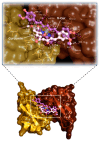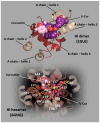Evaluation of the Anti-Amyloid and Anti-Inflammatory Properties of a Novel Vanadium(IV)-Curcumin Complex in Lipopolysaccharides-Stimulated Primary Rat Neuron-Microglia Mixed Cultures
- PMID: 39796150
- PMCID: PMC11720140
- DOI: 10.3390/ijms26010282
Evaluation of the Anti-Amyloid and Anti-Inflammatory Properties of a Novel Vanadium(IV)-Curcumin Complex in Lipopolysaccharides-Stimulated Primary Rat Neuron-Microglia Mixed Cultures
Abstract
Lipopolysaccharides (LPS) are bacterial mediators of neuroinflammation that have been detected in close association with pathological protein aggregations of Alzheimer's disease. LPS induce the release of cytokines by microglia and mediate the upregulation of inducible nitric oxide synthase (iNOS)-a mechanism also associated with amyloidosis. Curcumin is a recognized natural medicine but has extremely low bioavailability. V-Cur, a novel hemocompatible Vanadium(IV)-curcumin complex with higher solubility and bioactivity than curcumin, is studied here. Co-cultures consisting of rat primary neurons and microglia were treated with LPS and/or curcumin or V-Cur. V-Cur disrupted LPS-induced overexpression of amyloid precursor protein (APP) and the in vitro aggregation of human insulin (HI), more effectively than curcumin. Cell stimulation with LPS also increased full-length, inactive, and total iNOS levels, and the inflammation markers IL-1β and TNF-α. Both curcumin and V-Cur alleviated these effects, with V-Cur reducing iNOS levels more than curcumin. Complementary insights into possible bioactivity mechanisms of both curcumin and V-Cur were provided by In silico molecular docking calculations on Aβ1-42, APP, Aβ fibrils, HI, and iNOS. This study renders curcumin-based compounds a promising anti-inflammatory intervention that may be proven a strong tool in the effort to mitigate neurodegenerative disease pathology and neuroinflammatory conditions.
Keywords: amyloid precursor protein; curcumin; lipopolysaccharides; mixed neuron-glia cultures; neuroinflammation; vanadium-curcumin complex.
Conflict of interest statement
The authors have no competing interests to declare that are relevant to the content of this article.
Figures







Similar articles
-
Solid lipid curcumin particles provide greater anti-amyloid, anti-inflammatory and neuroprotective effects than curcumin in the 5xFAD mouse model of Alzheimer's disease.BMC Neurosci. 2018 Feb 23;19(1):7. doi: 10.1186/s12868-018-0406-3. BMC Neurosci. 2018. Retraction in: BMC Neurosci. 2023 Feb 24;24(1):16. doi: 10.1186/s12868-023-00785-5. PMID: 29471781 Free PMC article. Retracted.
-
Coadministration of Monophosphoryl Lipid and Curcumin Modulates Neuroprotective Effects in LPS Stimulated Rat Primary Microglial Cells.Oxid Med Cell Longev. 2024 Nov 28;2024:9422312. doi: 10.1155/omcl/9422312. eCollection 2024. Oxid Med Cell Longev. 2024. PMID: 39640288 Free PMC article.
-
Modelling neuroinflammation in vitro: a tool to test the potential neuroprotective effect of anti-inflammatory agents.PLoS One. 2012;7(9):e45227. doi: 10.1371/journal.pone.0045227. Epub 2012 Sep 20. PLoS One. 2012. PMID: 23028862 Free PMC article.
-
Assessment of Novel Curcumin Derivatives as Potent Inhibitors of Inflammation and Amyloid-β Aggregation in Alzheimer's Disease.J Alzheimers Dis. 2017;60(s1):S59-S68. doi: 10.3233/JAD-170071. J Alzheimers Dis. 2017. PMID: 28453488 Free PMC article.
-
Demethoxycurcumin, a natural derivative of curcumin attenuates LPS-induced pro-inflammatory responses through down-regulation of intracellular ROS-related MAPK/NF-kappaB signaling pathways in N9 microglia induced by lipopolysaccharide.Int Immunopharmacol. 2010 Mar;10(3):331-8. doi: 10.1016/j.intimp.2009.12.004. Epub 2009 Dec 16. Int Immunopharmacol. 2010. PMID: 20018257
Cited by
-
Emerging Insights into Brain Inflammation: Stem-Cell-Based Approaches for Regenerative Medicine.Int J Mol Sci. 2025 Apr 1;26(7):3275. doi: 10.3390/ijms26073275. Int J Mol Sci. 2025. PMID: 40244116 Free PMC article. Review.
-
Recent Insights on the Role of Nuclear Receptors in Alzheimer's Disease: Mechanisms and Therapeutic Application.Int J Mol Sci. 2025 Jan 30;26(3):1207. doi: 10.3390/ijms26031207. Int J Mol Sci. 2025. PMID: 39940973 Free PMC article. Review.
References
MeSH terms
Substances
LinkOut - more resources
Full Text Sources

